Phage Phrenzy: Science and Art Collide at the Science and Industry Museum
Posted on November 24, 2023 by Dr Aisling Brady and Yueyi Cai
Dr Aisling Brady and Yueyi Cai take us through their experiences in public outreach at the Science and Industry Museum in Manchester, bridging the gap between scientific breakthroughs and public awareness.
In the microscopic world, there’s a fascinating battleground where bacteria face their most formidable foes – bacteriophages.
Bacteriophages, commonly known as phages, are viruses that infect bacteria. They are not only the most abundant and diverse organisms on Earth but also have a fundamental impact on all biological life on the planet. The estimated global population of tailed phages reaches an astonishing 1031- exceeding the total number of all other organisms on Earth combined! For millions of years, phages have been in an evolutionary battle with their bacterial hosts involving both relentless warfare and ingenious partnership. Over the last century phages have been invaluable in a multitude of ways, making their mark on biology, medicine and beyond.
The realm of phage biology has led to the discovery of numerous useful enzymes and molecular biology processes, including restriction enzymes, the CRISPR-Cas system, and even some of the first understanding of gene regulation.
Despite the growing awareness of phages, the term “virus” remains largely linked to negative connotations, particularly following the emergence of the COVID-19 global pandemic. The rise of novel and highly contagious viruses understandably alarms us. Yet our own bodies harbour around 380 trillion viruses, a majority of which coexist with us. In fact, scientists around the world are now turning phages into valuable allies as phage therapy in our ongoing fight against infectious diseases. With its great potential to combat bacterial infections, particularly those resistant to antibiotics, we have an opportunity to revolutionise treatments in the future. However, for this potential to be fully realised, effective communication is crucial to bridge the gap between scientific breakthroughs and public awareness, ensuring everyone understands the promise and power of these microscopic heroes.
Against this backdrop, the Prophage Puppet Masters team has emerged. This joint research team, funded by the Biotechnology and Biological Sciences Research Council (BBSRC), consists of researchers from the University of Salford and the University of Liverpool. The team is conducting ground-breaking research to uncover how phages enable bacteria to survive better within the body and cause diseases. This work could offer new avenues for tackling various bacterial diseases. To effectively convey this crucial information, the team has also developed a range of diverse and enriching activities to allow wide audiences to learn about phages in an enjoyable format.
This October, we joined the collaboration for “Get Curious” at The Science and Industry Museum in Manchester. 700 visitors came to learn about phages and talk with us about our work. We really enjoyed meeting with families and demonstrating the wonder of phages through immersive activities and crafts:
Interactive 3-D infection models and a virtual reality (VR) visit into diseased lungs
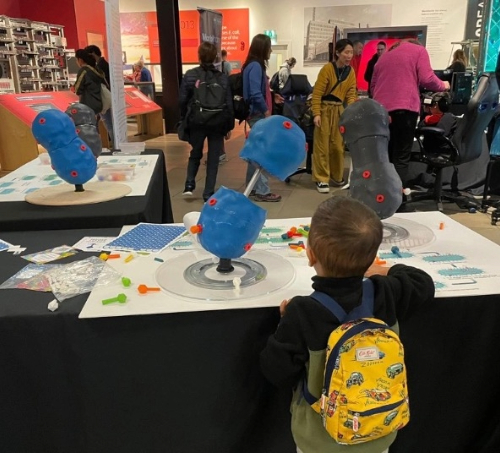
Using large 3-D printed models of bacteria and phages (above), visitors were given the opportunity to manually "manipulate" phages to infect bacteria by trying to fit the right phage tail shape with the corresponding shape hole (bacterial cell surface receptor). Visitors could then observe changes in the bacteria post-infection and gain a better understanding of the different ways that bacteria and phages interact.
Visitors also had the chance to get (virtually) inside the lungs of a cystic fibrosis patient. In collaboration with the artist Paul Miller, and Reflex Arc, this immersive activity allowed visitors to witness complex biofilms in diseased lungs and how phages might affect bacteria in this environment (below). These activities were also showcased as part of the prestigious Summer Science Exhibition at the Royal Society in London and Lightwaves festival at Media City last year.
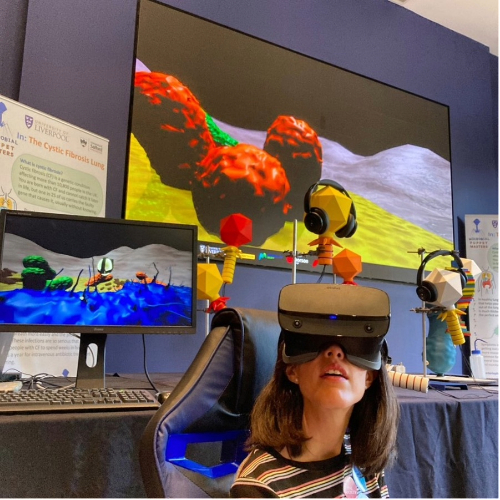
Faberge Phage: paper model workshop
Visitors had the opportunity to get crafty while learning about the spectacular structures of phages by creating cardboard models to take home. Armed with nothing more than some card, scissors and an array of colourful decorations, participants gained knowledge about the intricate structures that make up a phage. By combining creativity with scientific exploration, this activity offered a simple yet engaging way to visualise what these viruses actually look like, fostering a newfound appreciation for the sheer diversity that exists in the world of phages.
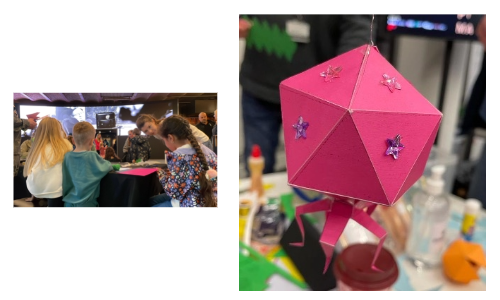
Reem Almeran, a third year PhD student at the University of Liverpool, UK who helped at the event said: “This was a unique and marvellous activity. It allowed me to talk about phages with people of different ages. I was delighted when I saw visitors’ reaction to hearing about phages for the first time, especially when they found out that many of these phages could be used as new therapies to help eliminate drug-resistant bacteria. Talking with children is amazing as they bring forward so many questions, making me think about different aspects of my own research!”.
Through these diverse platforms and activities, the team aims to engage with a broader audience, of different ages and backgrounds, about the significance of phages, dispelling the notion that not all viruses are harmful, and finding out what people think about phage therapy. Professor Chloe James, who has led the development of these activities says: “We really value our museums and other institutions that provide such excellent opportunities to engage with publics about our work. None of this would be possible without the dedication and passion of so many early career researchers that love to wax lyrical about microbiology and the world of phage. Thanks also to The Microbiology Society, who have supported us in widening our reach. These events are brilliant for building confidence in science communication skills that are so important in society today”.
To date, the team has actively promoted their 'Microbial Puppet Masters' project nationwide and has attracted thousands of visitors. Surveys indicate that visitors agree or strongly agree that the team's work helps them better understand what STEM professionals do and how STEM research impacts their lives. This further proves that such public engagement activities can not only bolster the societal support and environment for this research team but also for academic research at large.
A little bit about the blog authors...
Diving into the intricate realm of phage biology is a passion that fuels the research endeavours of both Dr Aisling Brady and Yueyi Cai from the Institute of Infection, Veterinary & Ecological Sciences at the University of Liverpool.
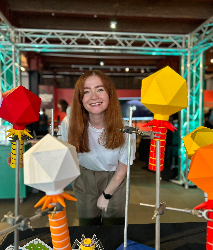
Dr Aisling Brady
“I spent my PhD working on a fascinating communication system carried by phages that infect Bacillus bacteria and it just blew my mind that viruses can talk to each other! Now, in my current postdoc in Liverpool, I am studying African Salmonella and delving into the genetics behind their ability to cause bloodstream infections. But my fascination with phages is far from over! In fact, this summer we had an excellent student, Holly Richardson, join our lab through a Harry Smith Summer Studentship. Holly successfully isolated novel phages with the ability to kill African Salmonella, a bacterium that causes significant mortality across Sub-Saharan Africa. This discovery has really ignited our enthusiasm for exploring the potential of phage therapy in the battle against these deadly pathogens and it’s fantastic to have public engagement opportunities such as this to talk about our work!”.
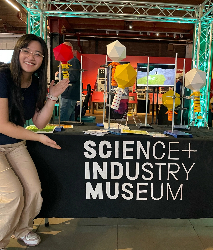
Yueyi Cai
“I am in the final year of my PhD, studying prophage-host interactions. My supervisor is Prof. Heather E. Allison. What got me into phages was hearing about how they could be used to treat bacterial infections — using viruses to fight bacteria seemed like a super cool idea! During my PhD, I've also found out that some phages can carry toxin genes and kind of "kidnap" the host with tiny bits of DNA to make the host do what they want. The world of microbes is full of surprises; it's like reading a detective novel by Agatha Christie, and with my research, I'm flipping to the next unseen page.”
In the wake of this exhilarating public engagement event showcasing the captivating world of phage research, led by the dedicated teams from the University of Liverpool and the University of Salford, we're thrilled to see the resounding enthusiasm and curiosity that it ignited. From interactive 3-D infection models to the immersive VR lung infection experience and the hands-on creation of model phages, it's been a journey of discovery and connection. Following the resounding success of this event, the Microbial Puppet Masters project team eagerly anticipates orchestrating our next installation, where we'll continue to unveil the wonders of phage research and its potential to transform our understanding of the microbial world. Stay tuned for more exciting revelations and interactive experiences on the horizon!

